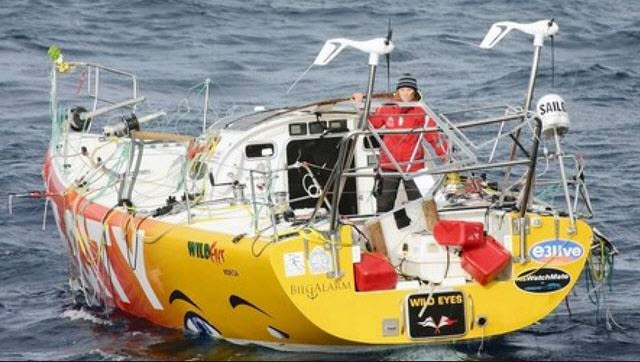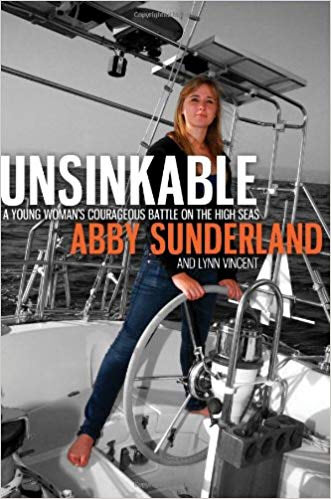Responsibilities after the rescue

Published on January 14th, 2019: New England boating columnist Joe Cooper offers his thoughts on the environmental, legal, moral, ethical and practical issues surrounding boats abandoned at sea.
We are well aware of the various types of pollution and other stresses that our playground, the world’s oceans, are under these days. Plastics are the popular target, but a bigger item is now in the news.
The discovery of the upside-down boat off Kangaroo Island, Australia, being identified as Wild Eyes, the Open 40 which Abby Sunderland abandoned after capsizing and dismasting in the Indian Ocean 10 years ago, has brought to the surface a multitude of opinions on issues surrounding a fair-sized chunk of abandoned carbon fibre, currently home to a barnacle population of considerable size, left to rot in the ocean.
The word from Kangaroo Island is that the local fisherman want it removed, claiming it is a hazard to navigation. Although if the Island’s fleet of fishing boats is anything like those in Newport (RI), 50 to 70-foot, 80,000 pound or more steel monsters, then likely they would not know they hit Wild Eyes until they were back to the dock and wondering what the yellow scratches on the bow are.
There is a distinct possibility it may simply wash ashore and break up on the iron bound coast. For a locale relying on pristine environment for much of its tourist trade (“pristine beaches” is a well-used phrase describing the island on various travel websites), this is not the good look either.

Some irony in the book title considering the state of her boat.
There are reports from the locals that the Sunderland family is interested in salvage, something the fisherman, currently in their prime season, are not willing to do pro bono.
The local Coast Guard is a volunteer operation and of limited resources so it is unlikely they will go and collar the wreck. All of this begs the broader question: What are the issues surrounding responsibilities for abandoned yachts?
Over the years, not a few race boats have come to grief “down there”. Races covering the last almost 40 years, from the first BOC, then The Around Alone, the Vendee Globe and lately the Golden Globe Race, have all experienced sailors being rescued and leaving boats abandoned in the loneliest place in the world.
More than one commentator on various sailing sites and forums have expressed outrage that they, Abby, abandoned the boat and did not take responsibility for the wreckage and subsequent pollution to the ocean. In the scheme of ocean pollution, one upside down carbon 40-footer is small beans compared to say, the Pacific Gyre, Fukishima radioactive water, the deplorably painful deaths of all manner of sea life from plastic (watch A Plastic Ocean for full particulars).
Some ten thousand containers reportedly wash off ships every year. Even the Volvo Ocean Race had taken steps to measure the pollution in the same regions Wild Eyes has been idling through, and comes up with micro beads largely from, apparently, the polar fleece clothing we all wear. If we are upset by just one capsized drifting boat, are we going to forgo our lovely toasty fleecy kit and return to wool?
I responded to some of the posters who were demanding the Sunderlands do something to remove the boat by inquiring about their own plans for removing their boat in the event they needed to abandon ship, or what make of reusable water bottle they used. All was silence.
At the other end of the oceans, off the coast of Holland, a container ship recently lost 270 odd containers. Apparently, some of the containers carried hazardous chemicals that are now washing up on the Dutch/German shoreline. Reportedly the local mayors have taken suit against the ship’s owners for the cost of recovering the containers and pollution mitigation along shore.
One poster opined that shipping companies are responsible for lost containers so why should not an individual?
A search of the International Maritime Organization’s (IMO) website using the term ‘responsibility for lost containers’ turns up information on the requirements and rules for hazardous materials but nothing about the lost container itself.
In the case of Wild Eyes, the 20 or so gallons of diesel, the 6 pints of engine oil and a quart or two of cooling liquid are presumably long dispersed into the massive maw of the Indian ocean, so the Exxon Valdez it ain’t, but the container is still adrift.
A report from 2011 on the website Shipping and Freight Resource is interesting and partially addresses the “responsibility” issues and remedies. In sum, a container ship lost some boxes off Monterey Bay. One managed to land within the Monterey Bay National Marine Sanctuary, where it was discovered by scientists from the Monterey Bay Aquarium Research Institute.
The institute is conducting research into the effects of a container crash landing into Sponge Bob’s back yard. The kicker, and no surprise economics plays a role, is the research is being funded by monies paid, described as a “Settlement” in the story, by the shipping company to NOAA.
Another piece on the on the same incident at the NPR website reports that the fiscal dividing line was the container landing in a national sanctuary which is specifically not allowed, hence the settlement (a fine by any other name) to fund the research.
Is there really a “need” for countries to propagate rules covering responsibilities for abandoned private sailing boats? Are boats being abandoned at sea at such rates the ocean is at risk of damage from them all? What would be viable legislation to oblige mariners to recover their abandoned boats? What would it say? Who would enforce it? What might be the penalties? Might one be able to get insurance to cover yourself for such hazards?
Alex Thomson’s recovery of his IMOCA 60 Hugo Boss from the middle of the North Atlantic not long ago was motivated more, I suspect, by the realities of boat building finances. It was likely cheaper to recover the boat than build a new boat, relegating, by default of finances, the environmental issues to the Silver medal.
Some posters mined the theme of “we clean up the trash we leave behind at the ….” (insert venue of choice), “so ‘they’ ought to be responsible for cleaning up their trash in the ocean.” A perfectly reasonable proposition that immediately goes hard aground on the realities of finances. Not everyone, in fact hardly anyone, except Alex, has the (financial) resources of his racing program.
Some played The Guilt Card. “How can they be so greedy as to just dump their trash in the ocean?” I own a lovely dog and I wondered about running out of poop bags miles into a forest and so not being able to clean up her waste. Sure, I’d feel bad, slightly guilty.
I try to be a good dog owner and clean up, but let’s face it, the odds of someone stomping onto my pup’s poop in such a remote area, and the ecological implications of discarded waste in a huge forest, a space infinitely smaller in area and volume than the oceans, is many decimal places small. And in the scheme of the world’s pollution, caused by manufacturing of things we “need”, is even more zeros after the dot.
Such global requirements mandating recovery of an abandoned boat, were they even possible to produce in the maelstrom that is international treaties, would, I think, ultimately place the burden back to insurance companies. Anyone sailing alone is likely not carrying insurance, especially that far offshore and especially in that kind of endeavor, so the burden would revert to the “owners” as in the current case.
What then is a practical method for making it viable for sailors who abandon their yachts to have some (financial) hope of recovering them, assuming that recovery is the best way to mitigate the “environmental” aspects of abandoned yachts? Bear in mind all this has surfaced only after the boat was sighted near land. The ensuing outrage has been missing for some 10 years.
Wild Eyes was built with flotation foam as per the class race rules and so did not and could not sink. Would it be “better” if she had sunk? From the empirical science point of view, what exactly is the hazard to the world’s ocean from one inverted 40-foot mound of carbon fiber and epoxy chemicals? Would the attendees relaxing on Sponge Bob’s Indian Ocean station be more inclined to inhabit a nice, curved, round thing versus a hard, cold metal box?
I am inquiring of people that might have answers to the question, about examining the yacht with a view to studying the effects of 10 years in the ocean on such a composite structure. What happens to the structure? Does it make micro carbons? Pictures show that barnacles seem to like it; might this be a new aqua culture proposition? What are the possibilities for reviewing the engineering of the boat?
The keel has disappeared, one assumes after Abby was hoisted off. How did this failure occur? Investigation is the only way to get merely into the same zip code as the answers to these questions. It is not every day one gets the opportunity to examine a composite structure that has been exposed to such harsh conditions.
In one sense it is a waste to not take advantage of salvage for the study of the boat and what results such investigation might offer to those responsible for the engineering of such boats or in fact composite structures in general, seeing they are becoming more widespread in all manner of arenas.
Like all good detective stories, there are more questions than answers on this topic. For now, I will hug my reusable water bottle and make sure I am always fully kitted out with doggy poop bags.
Story from Scuttlebutt Sailing News










